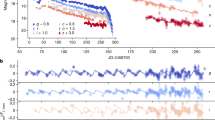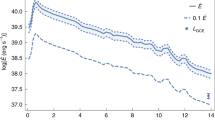Abstract
Fürst et al.1 have reported that the nonthermal galactic radio source G18.95–1.1 shows arc-like structures pointing towards the radio peak near its centre, and that its morphology does not conform to any known class of supernova remnants (SNRs). They propose an accreting binary origin for the source, following the suggestion by Helfand and Becker2 for the galactic nonthermal radio sources G5.3–1.0 and G357.7–0.1, which show filamentary structure and a compact feature along the axis of symmetry near the brightest edge of the extended emission3,4. But recently these two sources have been shown to be SNRs5,6. The compact feature in G537–0.1 is identified with a compact HII region, and there is no direct evidence for a binary in any of these sources. Although de Kool and van den Heuvel7 have modelled these sources as accreting binary systems, the details of conversion of energy into radio filamentary structure are not apparent. In view of the suggested peculiar morphology of G18.95–1.1, high-resolution (96x 36 arc s) low-frequency (327 MHz) observations were made using the Ooty Synthesis Radio Telescope (OSRT)8. This high-resolution map of G 18.95–1.1 is consistent with the conventional shell-type morphology around a central object.
This is a preview of subscription content, access via your institution
Access options
Subscribe to this journal
Receive 51 print issues and online access
$199.00 per year
only $3.90 per issue
Buy this article
- Purchase on Springer Link
- Instant access to full article PDF
Prices may be subject to local taxes which are calculated during checkout
Similar content being viewed by others
References
Fürst, E., Reich, W., Reich, P., Sofue, Y. & Handa, T. Nature 314, 720–721 (1985).
Helfand, D. J. & Becker, R. H. Nature 313, 118–119 (1985).
Becker, R. H. & Helfand, D. J. Nature 313, 115–118 (1985).
Shaver, P. A., Salter, C. J., Patnaik, A. R., van Gorkom, J. H. & Hunt, G. C. Nature 313, 113–115 (1985).
Caswell, J. L. et al. Mon. Not. R. astr. Soc. 225, 329–334 (1987).
Shaver, P. A. et al. Astr. Astrophys. 147, L23–L24 (1985).
de Kool, M. & van den Heuvel, E. P. J. Nature 317, 599–600 (1985).
Swarup, G. J. Astrophys. Astr. 5, 139–148 (1984).
Milne, D. K. Aust. J. Phvs. 32, 83–92 (1979).
Downes, A. J. B., Pauls, T. & Salter, C. J. Mon. Not. R. astr. Soc. 218, 393–407 (1986).
Hughes, V. A., Harten, R. H., Costain, C. H., Nelson, L. A. & Viner, M. R. Astrophys. J. 283, 147–153 (1984).
Author information
Authors and Affiliations
Rights and permissions
About this article
Cite this article
Patnaik, A., Velusamy, T. & Venugopal, V. Is the G18.95–1.1 radio source a shell-type supernova remnant with a central object?. Nature 332, 136–137 (1988). https://doi.org/10.1038/332136a0
Received:
Accepted:
Issue Date:
DOI: https://doi.org/10.1038/332136a0
Comments
By submitting a comment you agree to abide by our Terms and Community Guidelines. If you find something abusive or that does not comply with our terms or guidelines please flag it as inappropriate.



